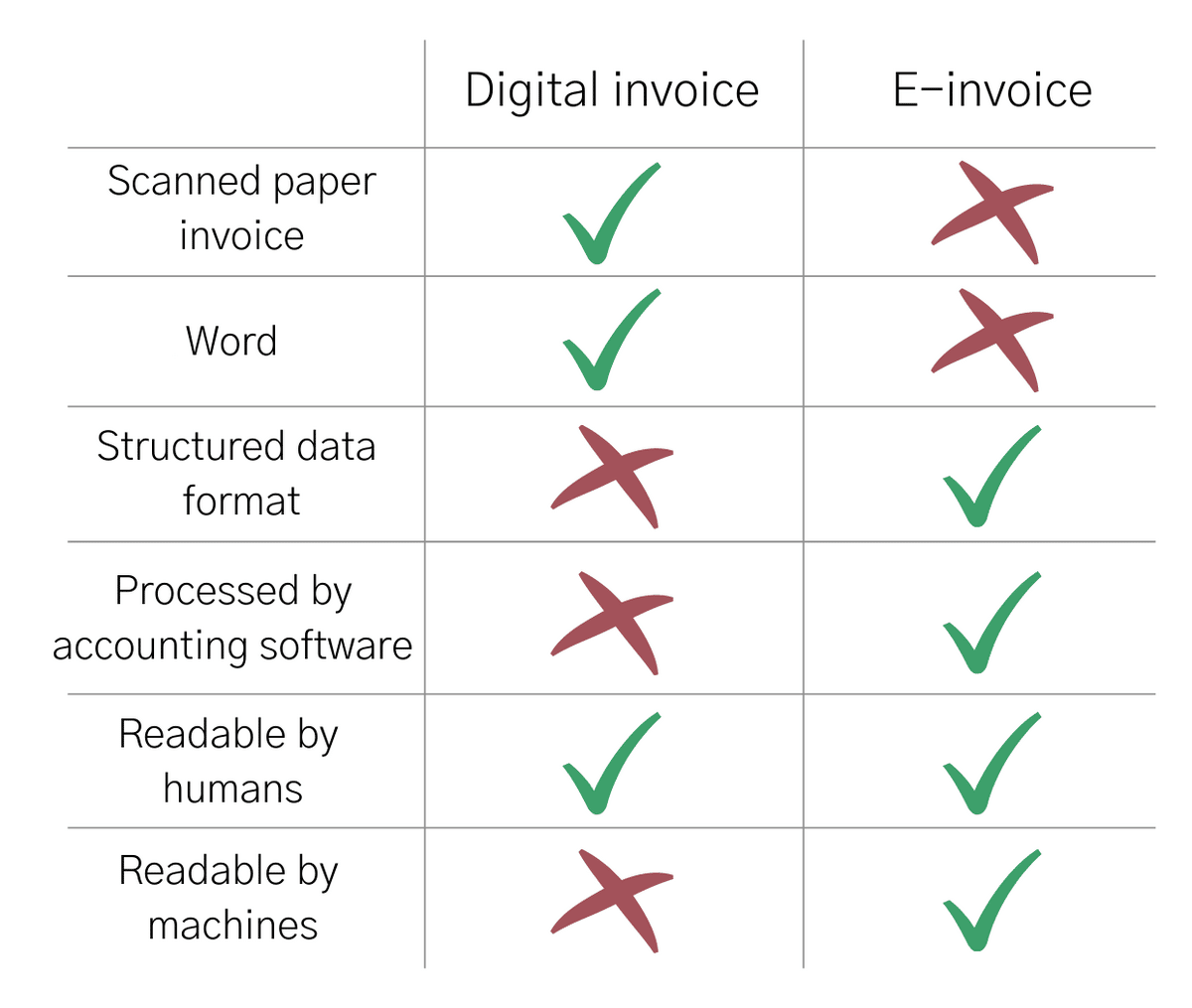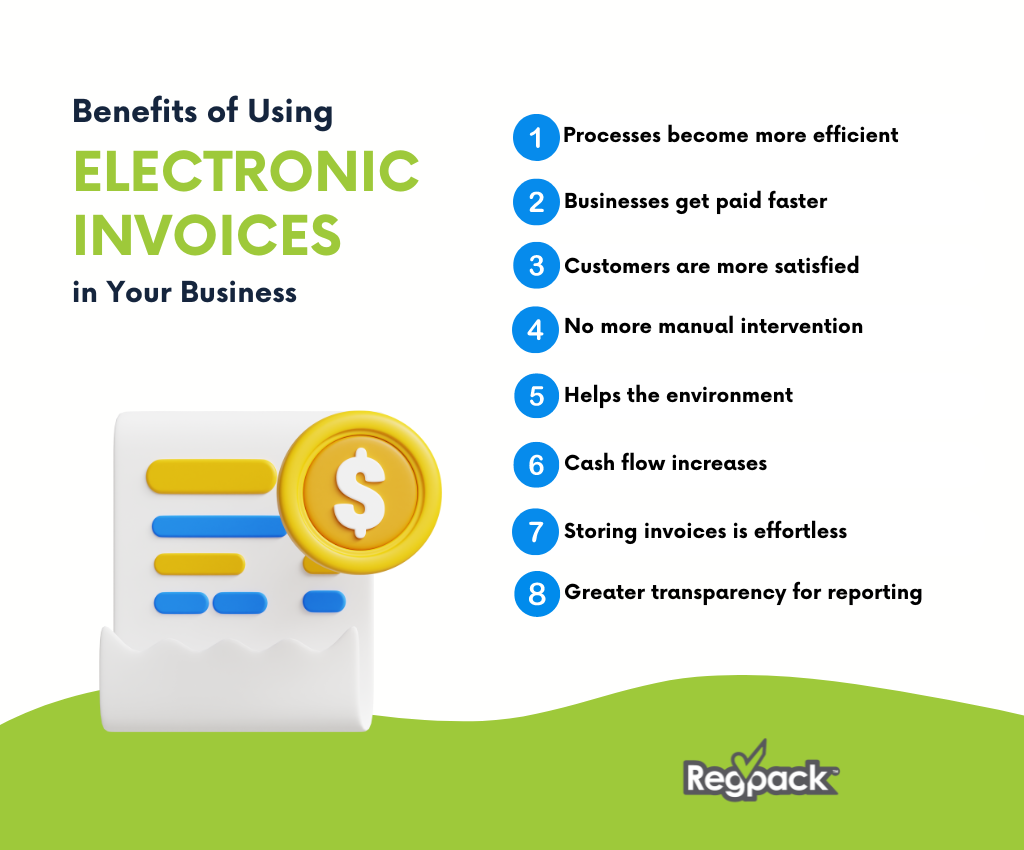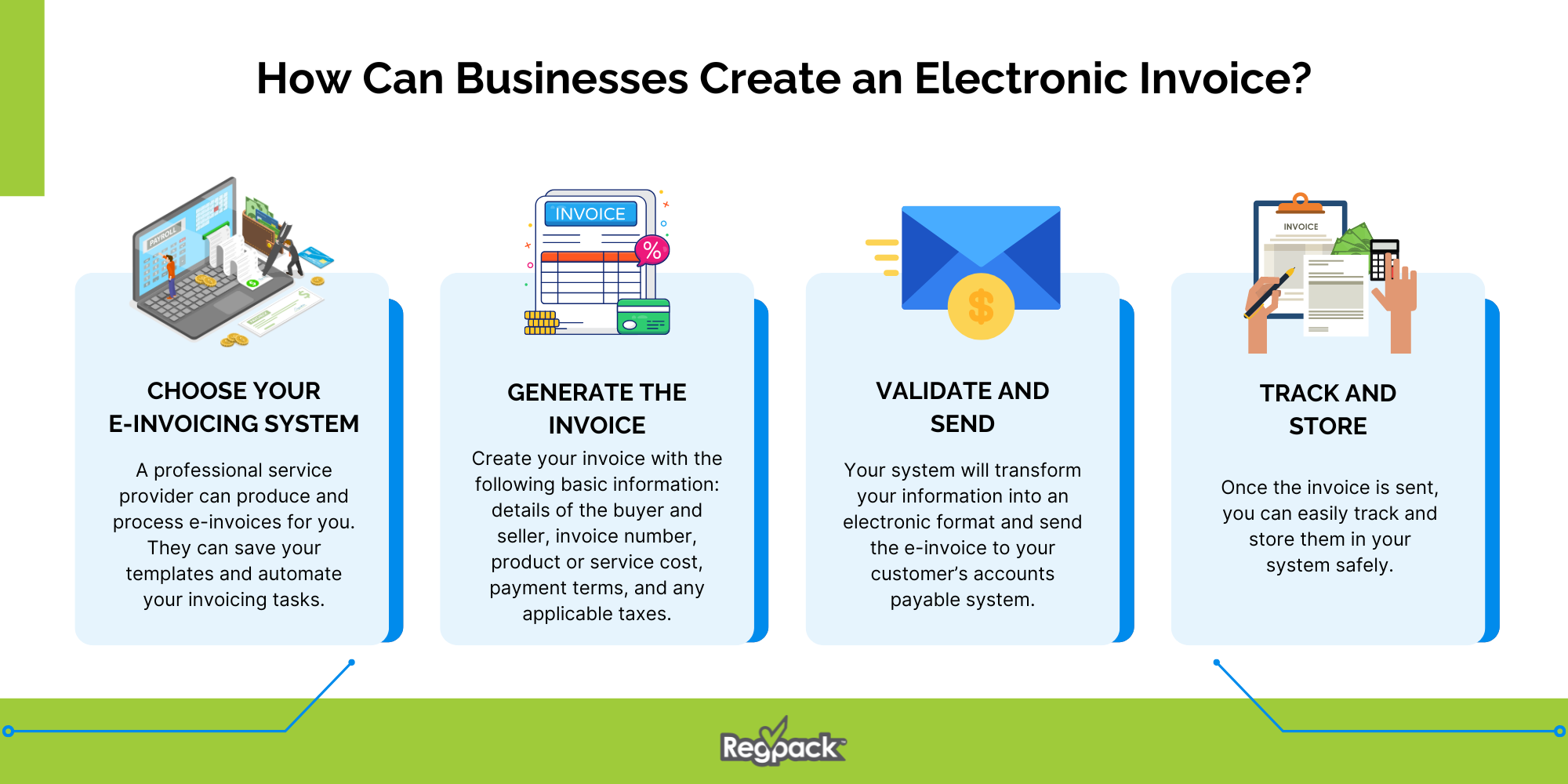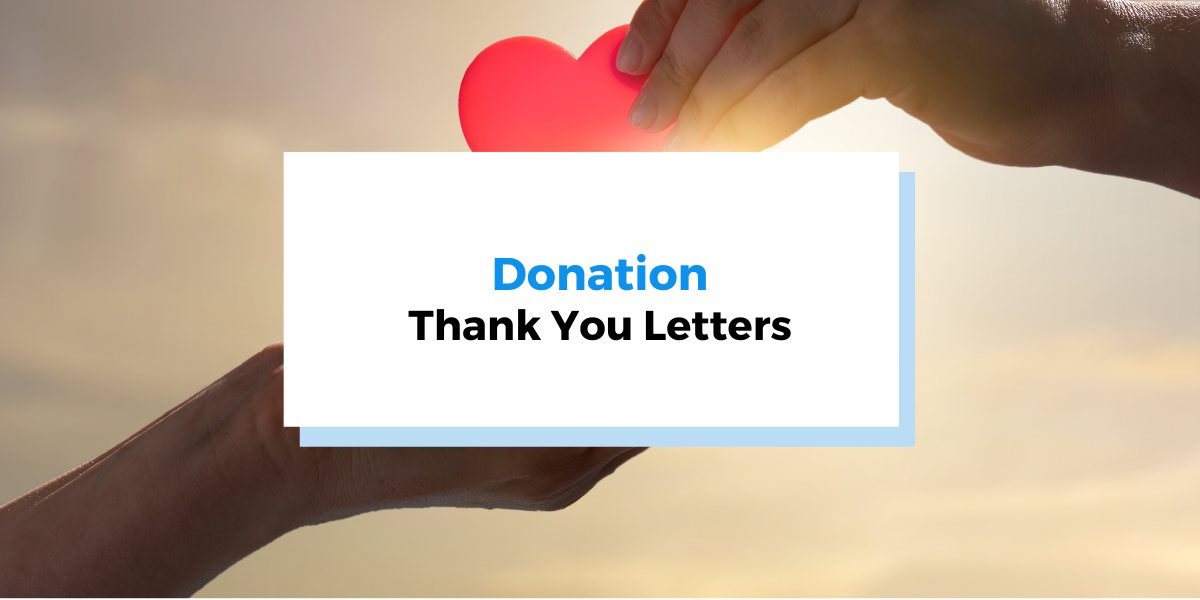Electronic invoicing gets a lot of attention, but few business owners have an understanding of what it is, how it works, and the many benefits this technology can provide.
In this article, we’ll teach you all you need to know about e-invoices, including the basics, history, and challenges companies face during this digital transformation.
- What Is Electronic Invoicing?
- Digital Invoice vs. Electronic Invoice
- The History of E-Invoicing
- Benefits of Using Electronic Invoicing in Your Business
- What Are the Challenges of E-Invoicing?
- How Can Businesses Create an Electronic Invoice?
- Conclusion
What Is Electronic Invoicing?
An electronic invoice, commonly referred to as an e-invoice, is a bill that’s issued and received in an electronic format. This invoice type is sent, processed, received, and stored digitally.
The process starts by creating an invoice with an electronic invoicing system. This information is then securely exchanged between service providers and clients via a digital exchange system. This process eliminates the need for paper invoices and doesn’t involve any manual intervention.
Because of this specific structure, the data from the electronic invoice can be integrated into the recipient’s accounts payable system, without the need for manual data entry from an administrator. And it’s immediately stored in your accounts receivable system as well.
Digital Invoice vs. Electronic Invoice
It’s important to note that electronic invoices are a subset of digital invoices.
A digital invoice is any invoice that is produced and sent through digital means. For example, if you create a bill in a Word document or a spreadsheet and send it via email, it’s a digital invoice. However, digital invoices lack certain qualifications to be considered e-invoices.
For an invoice to be regarded as an electronic invoice, it must meet the following criteria:
- Electronic invoices have data structured in a specific way that enables the buyer’s financial transactions and systems to integrate into their system automatically.
- The structured invoice data is issued in XML file or Electronic Data Interchange (EDI) and using standardized web forms.
- The data file transfer occurs between computer systems, and the average human, although capable of reading the e-invoice’s exterior, would be unable to make sense of the code behind the scenes.

Source: Summitto
In simple words, all electronic invoices are digital but not all digital invoices are electronic. Although digital invoices save your team time and reduce paperwork, they don’t offer the same boost to billing team efficiency that you’ll get with e-invoicing.
The History of E-Invoicing
E-Invoicing as we understand it now didn’t just happen overnight. Its history can be traced back to the ’60s with the advent of electronic data interchange (EDI) systems. These systems were designed to electronically transfer documents like purchase orders between companies.
In the ’90s, as more businesses got connected to the internet, EDI systems were gradually replaced by web-based solutions. The focus shifted from just transmitting documents to processing transactions digitally.
The term ‘Electronic Invoicing’ became more popular in the early 2000s when companies started developing dedicated e-invoicing solutions to digitize the entire invoicing process. Governments across the world acknowledged the benefits and started pushing companies to adopt e-invoicing.
European Commission, in particular, saw the potential for massive savings and made it a requirement for public administrations. Eventually, countries like Mexico and Brazil took it a step further by mandating e-invoicing for all business transactions.
Today, electronic invoicing is expected to be a standard business practice worldwide. It’s no longer a question of if businesses will adopt e-invoicing, but when and how.
Benefits of Using Electronic Invoicing in Your Business

Changing from paper invoices to electronic ones isn’t just about going digital. It has a lot of benefits that can help any business, including:
- Increased Efficiency: E-invoices are created, sent, and stored digitally. No need for filing cabinets or paper management, everything is stored in electronic documents. All of this means the invoicing process becomes quicker and more efficient.
- Faster Payment Process: Once an e-invoice is sent, the accounts payable department on the other side can start processing it straight away. This helps to speed up payment time, meaning your business gets its money quicker.
- Customer Satisfaction: Paying you through e-invoices is a lot easier on your customers, especially if you give them multiple payment options (credit card). Being easy to work with can greatly improve convenience and reduce annual turnover.
- Improves Accuracy: E-invoices cut out the need for someone to type information from a paper invoice into a computer. This human intervention can often lead to mistakes. E-invoices ensure an accurate exchange of information which minimizes payment errors.
- Helps the Environment: Electronic invoicing helps a business be more environmentally friendly. Every e-invoice sent is one less piece of paper used. This helps your business reduce its carbon footprint and aids global conservation efforts.
- Improves Cash Flow: E-invoicing enables you to send and process invoices more quickly, leading to faster payments and increased cash flow.
- Easy Access and Storing: Storing e-invoices is effortless. All invoices are securely stored on servers which makes it simple to retrieve them when necessary.
- Greater Transparency: Most e-invoicing software enables you to easily report on invoices so you can dig into the data and find ways to improve your invoicing process.
Even better, if you’re using automated invoicing software, it likely comes with more features that streamline the invoicing process, allow you to view structured data formats, and even further reduce the cost of each e-invoice.
Whether you’re a small business or a large public administration, switching to electronic invoicing can make you faster, more accurate, eco-friendly, and profitable.
What Are the Challenges of E-Invoicing?
While e-invoicing is more efficient than paper or digital invoice format, it is not without its challenges, especially when implementing electronic processing systems.
Below are some of the main challenges you may face with e-invoicing:
- Steep Learning Curve: For a business used to traditional invoicing methods, switching to a different system, especially a digital one, may seem daunting. Getting everyone in the business, particularly the Accounts Payable team, to understand the new system can take time.
- System Integration: E-invoicing solutions need to be integrated with existing ERP systems, which can seem complex and time-consuming.
- Legal Requirements: In several parts of the world, particularly in the European Union, there are specific rules that an electronic invoice must follow. This includes things like digital signatures and electronic invoice formats. It is important to understand and implement these regulations.
- Different Standards: Different countries and industries have different e-invoicing standards. Adhering to these various standards can be a challenge.
- Cost of Implementation: The cost of implementing the system could also be a potential roadblock for small businesses.
Although these challenges may seem daunting, overcoming the initial obstacles can lead to long-term benefits.
How Can Businesses Create an Electronic Invoice?

Creating an electronic invoice doesn’t have to be hard. With the help of an electronic invoicing system, it can be as straightforward as filling out a form online.
- Choose Your E-Invoicing System: While some companies create their e-invoicing solution, most businesses use a system provided by a professional service provider. These systems are specifically designed to produce and process e-invoices and often come with extra features such as the option to save invoicing templates or automate parts of the invoicing process.
- Generate an Invoice: Once you get your e-invoicing system ready, the next step is to create an invoice. Like a regular invoice, it should include specific information such as:
- Details of the buyer and seller
- Invoice number and date
- A breakdown of products or services provided, with their costs
- Payment terms and methods
- Any applicable taxes and the total amount to be paid
- Validate and Send: The system will transform the information into an electronic format, often an xml file. Remember, your e-invoice has to follow local legal requirements. Some regions require a digital signature for authenticity, while others might have rules about the format your electronic invoice should take. Once validated, the system will send your invoice through the internet to your customer’s accounts payable system.
- Track and Store: One of the benefits of e-invoices is you can track them easily. Once sent, you can monitor their status until payment is received. All your e-invoices are stored safely in your system, making it simple to access past invoices when needed.
Conclusion
Businesses and service providers utilizing e-invoices are experiencing lower costs, less administrative work, competitive advantages, and happier customers and accounting staff members.
Although implementing and finding the right e-invoicing solution can be complex, it’s worth the investment.
If you’d like to get started with this journey, consider checking out Regpack one of the best solution providers for e-invoicing and a leading registration software provider. Regpack is an online payments platform designed to facilitate electronic billing and invoicing and be your business partner.


















